Protecting and restoring Ann Arbor's natural areas and fostering an environmental ethic among its citizens.Volume 25, Number 4
Winter 2020
Park Focus: Traver Creek Nature Area
Rebecca Naumenko, Conservation Worker 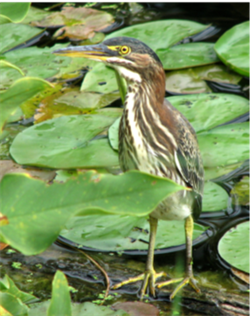
On the North side of Ann Arbor, just off Traver Road, lies the lesser-known gem of Traver Creek Nature Area. This long triangular green space totals 5.09 acres of hickory-walnut forest with black cherry dappling the understory. The single trail which bisects the park mainly attracts mountain bikers, though it is not uncommon to find families walking in to catch crawfish in the creek. Traver Creek is a tributary of the Huron River whose basin includes 11 natural areas in addition to Traver Creek Nature Area. Hikers can catch multiple glimpses of the tributary as they maneuver the path through Traver Creek, and this view is further enhanced by the hard work of an invested local community. Many honeysuckles have recently been cut back to allow for safe trail use while on a bicycle as well as to give an open view of the water.
Traver Creek's watershed is approximately 7 square miles of farmland and residential areas. Because of the many impervious surfaces that channel precipitation directly into the creek, it is prone to 'flashy'-ness. When a watershed is 'flashy' it will fill and flow quickly in rainy weather and when the spring melt comes. Conversely, it will flow low and slow when there has been no precipitation. Because of this, the creek bed is often very deep, and the changing waters can make the sight from the trail unique to each visit.
The nature area is bordered to the west by Leslie Park Golf Course and to the east by Foxfire South Park. Surrounding Traver Creek Nature Area are eight parks and nature areas totaling about 300 acres which serve as a habitat corridor for native fauna and are the largest greenspace within the city of Ann Arbor.
Animals which use these corridors, and more specifically Traver Creek Nature Area, include 48 types of butterflies, most predominantly cabbage white, little wood satyr, and silver-spotted skipper. Birds of note here include the Rose-breasted Grosbeak and the Green Heron.
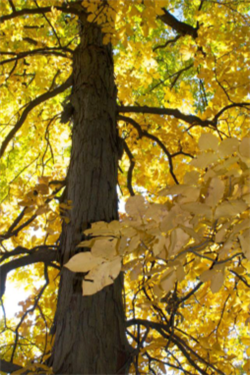
If one were to go scouting now for any of these aforementioned species, they will find the task challenging. These birds and butterflies migrate south to over-winter. Luckily, just because it is winter does not mean nature has come to a standstill. While walking the trails of Traver Creek, one can see rabbits, Blue Jays, Downy Woodpeckers, and white-tailed deer amongst other fauna. The flora of winter is best expressed as trees beautifully weighted by fallen snow. The trees that are most distinguishable by their bark in winter include black cherry which ranges from 50-80 feet in height when fully mature. The bark is a dark grey/black and peels up in curved chunks resembling burnt potato chips. We also see shagbark hickory, which, while unique in appearance, is common to this area. Tree height can be taller than 100 feet at maturity. It has bark that peels up in long strips and has a distinctly 'shaggy' appearance.
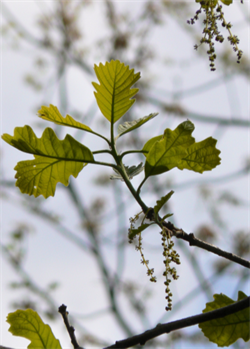
Along the eastern side of the park near the railroad tracks, we see a gathering of bur oaks lining the edge of a small prairie pocket. The bur oak is Ann Arbor's city tree, and is featured in the city logo as well as the Parks & Recreation logo and NAP's own logo. The most distinguishable feature may be the acorns which have a fringed edge at the top of the acorn's 'hat'. The prairie in the park is mostly a lumpy snow field now, but we can still see stalks of joe-pye weed, snakeroot, and boneset.
Prior to winter, many of these plants dropped seeds, which are now dormant in the soil. The accumulation of seed over the years is known as a seed bank. The seed bank of Traver Creek Nature area holds many valuable native plants, just waiting for the chance to sprout, including turtlehead and false sunflower. Sadly, they have many invasive competitors.
But this need not be the case forever! We at NAP hope to see many of you at future shrub removal workdays at this lovely park. Together we can clear out the buckthorn and honeysuckles, and give the native plants a competitive edge.
For your next woodland adventure, consider Traver Creek Nature Area. The view of the water in winter is truly a sight to behold, and since it is not overly busy, you can take a moment to yourself, breath in, and commune with nature.
Coordinator's Corner: Keep Going
2020 has been a tough year: the pandemic, racial unrest, political division, etc… The challenges just keep coming. For my family, October 13th brought one additional challenge. That's the morning we woke up to a house fire. The situation unfolded slowly: a burning electrical smell in the middle of the night, smoke in the house in the morning, but no apparent fire. It wasn't until the Fire Department cut a hole in our living room wall and smoke poured out that we started to realize what had happened. Poor design and workmanship had allowed the previous night's fire to escape through the back of the fireplace and into the wall. There it lingered and slowly grew. Very fortunately, no one was hurt, and the damage to the house was relatively minor. But to correct the situation, the entire two-story chimney needs to be removed, redesigned, and rebuilt. And, of course, there's smoke damage throughout the entire house. The end result is that we will be out of the house for six months or so while things are being repaired, cleaned, and repainted.
Our particular story may be unique, but the very real challenges of 2020 are ubiquitous. Every single one of us has been impacted by COVID. Some, I'm sorry to say, far worse than others. And the prognosis for this winter is not encouraging. We are all going through an extremely difficult period. It's at times like this that I'm reminded of one of my favorite quotes from Winston Churchill: If you're going through hell, keep going. To me, this is an encouraging reminder that things may be bad now, but they won't always be bad. We may be at a low point now, but better times are ahead, and we must not give up now, or we'll never reach those better times.
I don't mean to be glib about this. My losses related to the house fire are only temporary. Thanks to insurance, we will eventually have a better and safer house than we did previously. But some of you have incurred losses that can never be replaced, loved ones who were victims of 2020. Those are much harder losses to overcome. It's hard to move forward after such a setback. Hard to even imagine, let alone see, a brighter future.
Now is when we really need to come together as a community to support each other, to help our fallen comrades get back on their feet, and keep marching forward, toward a brighter future that we know is out there, even if they don't. At NAP, we're doing all we can to keep going, to continue our mission, despite the many challenges of 2020. Thanks for your patience, and your flexibility as we continue to make adjustments and modifications so we can move forward together. We hope that the work NAP does, and the natural areas we steward, can be a source of comfort and rejuvenation for all of you as we bring 2020 to a close, and look forward, with hope, to 2021.
-David Borneman, Natural Area Preservation Manager
Fallen Trees Host Thriving Communities
George Hammond, Field BiologistAs you walk through our nature areas, you will see trees that have fallen on the ground. Trees do eventually die of old age, but most of the fallen trees in our parks are not that old—they have been knocked down by storms, or killed by insects or disease. Some may have lost the struggle for sunlight and have been shaded out by taller trees around them. These fallen trees are a vital part of the woodland ecosystems we care for, and we are happy to have them!

When a tree falls and dies, it becomes an important new part of the landscape. For small animals they are vital cover, places to hide from the watchful eyes of predators. Chipmunks, shrews, and deer mice use them as runways, not along the top, but along one side, so they can't be seen from all directions. Soon small mammals tunnel under the trunks and large branches that are on the ground, creating burrows safe from hungry foxes. Other animals use the fallen trees as

resting spots. Squirrels and birds like to be able to see what's coming, and often rest on stumps and fallen branches while gnawing on walnuts or looking for food. Fallen leaves drift up against the downed trees too, creating more shelter for small creatures. The leaves help the trees and branches on the ground trap moisture too, and so salamanders and frogs hide in the moist spaces under logs.
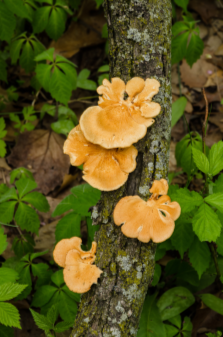
Fallen trees aren't just inert objects, though. For many organisms, a fallen tree is a great big chunk of food! Fungi, microbes, and insects (especially beetles) feed on the fallen wood, slowly digesting it. Wood is hard to digest, but rich in carbon compounds that microbes and fungi can slowly break down. A few animals eat wood; they rely on microbes in their guts to help with the digestion, or wait and eat wood after fungi have already grown through it. Though full of energy, wood is low in other nutrients like nitrogen. When decomposers start on a log, they bring nitrogen with them in spores or eggs, or pull it from the air or soil. When the wood is decomposed, much of the nitrogen they brought, plus what was in the wood, is released into the soil. A decomposed log is lower in energy, but is a rich source of nutrients for the plants and fungi around it.
All of these wood-eaters in turn nourish a diverse community of other animals - tons of insects, snails and other invertebrates. These in turn are food for frogs, salamanders, snakes, birds, and other animals. Woodpeckers hammer into on fallen logs, seeking beetle grubs within. Wrens pick small insects off the log, and Towhees scratch away in the leaves drifted around it. As the log ages and fungi grows through the wood, the log takes up more moisture, and cracks apart. The spaces inside become nurseries where small salamanders can guard their eggs. Frogs hide there too, emerging at night to hunt for bugs. When fires come, the cool spaces in and under fallen logs are vital refuges for these small creatures.
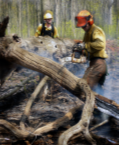
Sometimes trees fall but do not quite reach the ground. Perhaps propped up on their branches, or on another log, the whole process happens much more slowly. Without moisture and nutrients from the soil, the decomposers can only develop very gradually. The wood remains, hard and dry, for many years. This creates a challenge for NAP's controlled burn program. Big dry logs are more flammable than big logs on the ground. In some of our parks, NAP crew members may be doing some limited cutting of fallen logs. Not to remove them, only to get them down on to the ground, where they can support diverse communities of small creatures in the woods.
Changes to NAP Workdays in Response to COVID-19
NAP is closely monitoring recommendations from city and other health officials, and adapting workday protocols accordingly.
- Pre-registration is required at tinyurl.com/NAPWorkdays.
- Pre-registration closes at noon on the Friday before the workday.
- Participants must wear a mask and maintain a 6-ft distance from others at all times.
At all NAP workdays, please remember to dress for the weather and wear shoes suitable for uneven terrain and working off-trail. Please wear long pants, closed-toed shoes, a mask, and leather work gloves. Please bring a snack and bottle of water. All minors should be accompanied by a guardian.
NAPpenings
Welcome, new Park Steward!
Alyssa Pozniak, Miller Nature Area
Congratulations, Eagle Scout!
Matthew Penoyar, Wayfinding Posts, Bird Hills Nature Area
Thank you!
Many thanks to the groups who volunteered with NAP recently. We could not make such a difference without you!Duo Security
EMU BIO 226 (Global Ecology and the Environment)
Potawatomi Mountain Biking Association
UM Backpacking Club
UM Community Scholars Program
UM Epsilon Eta
UM Sustainable Living Experience
Washtenaw Technical Middle College
YMCA Youth Volunteer Corps
Staff Updates
Farewell…
 Hannah Bradshaw,
Communications and Special Events
Hannah Bradshaw,
Communications and Special Events: I am very grateful for my time here at NAP, and I am sad to leave this position! I've greatly enjoyed the opportunities to work outside in Ann Arbor's parks, as well as in the office, helping to make all our events happen behind the scenes! I've learned so much about invasive species removal and the parks system in general. Most importantly, I am incredibly grateful for all the wonderful people that I have met working at NAP, staff and volunteers alike. Though I am leaving work to be a full-time student, I will still see you in the parks for volunteer workdays since I'm sticking around as a part-time workday leader!
Welcome…
 Renee Hytinen
Renee Hytinen,
Communications and Special Events: After a six-year pause, I'm coming back to my old position editing the newsletter and helping get the word out about NAP's good works. NAP is a unique workplace—as is the NAP community at large—and I am grateful to be back working with all you great people, and excited to start this new chapter. Both of my kids were born during my previous time with NAP, and I now have a first grader, Isaac, and a third grader, Aaron. I'm looking forward to bringing them along to workdays and other NAP events once we are all able to gather safely again.
NAP 2020 by the Numbers
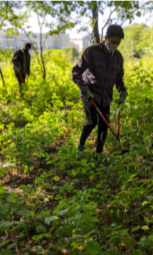
- NAP staff and volunteers performed prescribed burns on 35 acres in 5 parks. Our spring burn season was cut short due to the COVID-19 Pandemic.
- Overall, 1,022 volunteers contributed 5,971 hours of effort to our programs.
- 51 Breeding Bird Surveyors volunteered 546 hours and observed 195 species of birds.
- 7 Butterfly Surveyors volunteered 60 hours and identified 31 species across 8 parks.
- 18 Photo Monitoring volunteers spent 88 hours taking 320 photos in 20 parks.
- 30 Frog and Toad Surveyors volunteered for 110 hours and observed 8 species at 74 sites.
- 25 Salamander Surveyors volunteered for 134 hours and observed 6 species at 8 parks.
- 25 Turtle Stewards volunteered for 133 hours and observed 7 species all along the Huron River and in various parks.
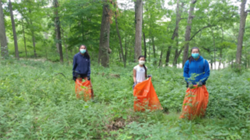
HELP US GROW!
Volunteers help us keep track of the plants and animals in our nature areas. Check the
calendar for the survey training and kickoff events coming in early spring. We would also be delighted to have you come to our public workdays, or
contact us about organizing a private workday for your group!
